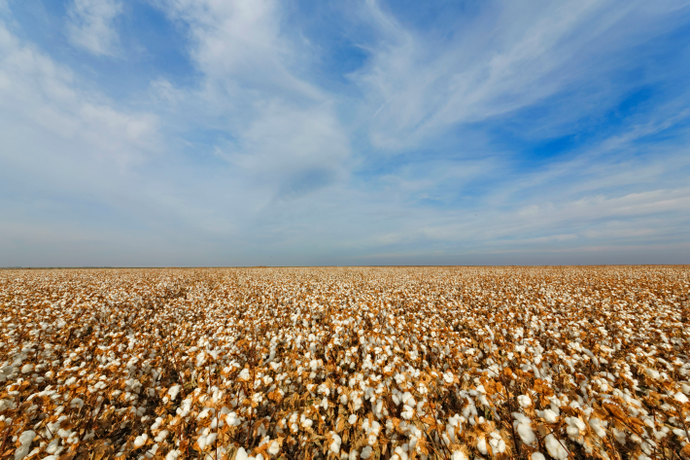
From Boll To Ball: The Lifecycle Of Cotton
Shelly Weaver-CatherAs soon as the sun starts to break through the gray of winter, the Southern half of the United States starts one of the most important growing seasons of the year—cotton. From February to June, farmers from the tip of Virginia to the lower half of California start sowing their cotton seed and prepare for one of America’s most crucial crops. The climate in places like Texas, Arizona, New Mexico, and Southern California makes for the perfect growing weather—hot and dry—and by the middle of October fluffy, white cotton will be exploding from their bolls and ready to move on to the next phase of life.
Cotton starts as just a tiny sprout—you probably don’t even see it from the road as you drive by. Over the next month, the plants will grow to between two and five feet tall, making their presence known and painting fields in stunning bright green as Spring gives way to the Summer heat. A few weeks later, buttery yellow blossoms develop and eventually they fade to pink and then deep red before falling away. The plant’s ovary is all that’s left, which forms into a pod and begins to look more like the cotton we recognize.
Most of what makes cotton identifiable happens out of sight, inside of a protective shell called a boll. The boll houses seeds that elongate and form fibers, which continue to strengthen and thicken over time. Eventually, cellulose starts to form alongside the fibers and puts pressure on the boll from the inside out. After enough cellulose forms, the boll cracks and reveals puffy, perfectly-sprouted cotton plants, ready for harvest.

Massive harvesters crawl through the fields in late October to reap what they’ve sown. Many cotton farmers use stripper harvesters, which have rollers to grab the entire boll from the plant as they weave in and out of the fields. Others use spindle pickers that only remove the cotton itself. Supima Cotton’sharvesters are state-of-the-art GPS-controlled machines that carve paths through their sprawling cotton fields across the American Southwest. After harvesting, the cotton is piled into large square loaves called modules, which can weigh more than 25,000 pounds.
These loaves are transported to local gins and heated to remove excess moisture, and run through a few cycles of cleaning to get rid of anything that got caught in the fibers along the way. The cotton pulls through a gin, which catches seeds in narrow ribs and allows the fiber to pass through. Cotton seeds head to storage and the fibers are compressed into massive bales, ready to head to textile mills. Next, cotton is sorted for sale. A number of factors will go into what level of quality cotton is considered, including color, strength, cleanliness, and the fineness of the crop. An expert will oversee this process, called a Classer, and make sure that bales are uniform and in the best shape possible.
By the time cotton gets from the field to a manufacturer, it could be sold and resold several times on the market.
While the cotton fiber itself is being cleaned and prepped for market, there’s still another aspect of the crop that needs some attention. Cottonseed is also a valuable product and has a few different uses. For every 100 pounds of cotton fiber, about 160 pounds of cottonseed can be harvested and reused for cottonseed oil, or ground up into cottonseed meal which makes excellent fertilizer or feed for livestock. Around 5% of the harvested seeds will be stored for next year’s planting season.

Back in the textile mills, the bales of cotton are ready to take a new form, and yarn production is starting. Several bales blend together to make sure that they are as uniform as possible, and machines spread the lint out to make what looks like a thin web. The webs travel through a trumpet that spins them into a fine, soft rope called a sliver. Multiple slivers draw together, around 8 at a time, to create the foundation for cotton yarns. These slivers twist and spin several times until the desired thickness, depending on the end-use for the yarn. This yarn can be wound around a spindle for use on its own, or twisted with others to form a ply yarn. Twisting multiple ply yarns together will form a cord, closer to rope in structure than thread.
These yarns will either be woven or knitted into fabric. Weaving the yarn on a loom creates a tight, more structured fabric, where using needles to knit yarns together usually results in a stretchier feel. To get an idea of the differences, look around your own home–your jeans and shirts are woven, your jersey sheets and favorite sweater are knitted. These fabrics will then be dyed, cut, and crafted into other things—clothing, bedding, home decor items, cotton is pretty much everywhere in your home.
Of course, cotton goes on to become other things, too. Beauty and medical products, like cotton balls and q-tips, are cotton fibers that have been bleached and sterilized. Cotton can also be found in bandages, book bindings, and even American money.
The uses for cotton are endless, and as the harvesting season winds to a close, the seeds will be stored in a clean environment that allows for plenty of aeration to make sure mold and insects don’t claim them. Come Spring, they’ll be planted to begin another year’s crop.



